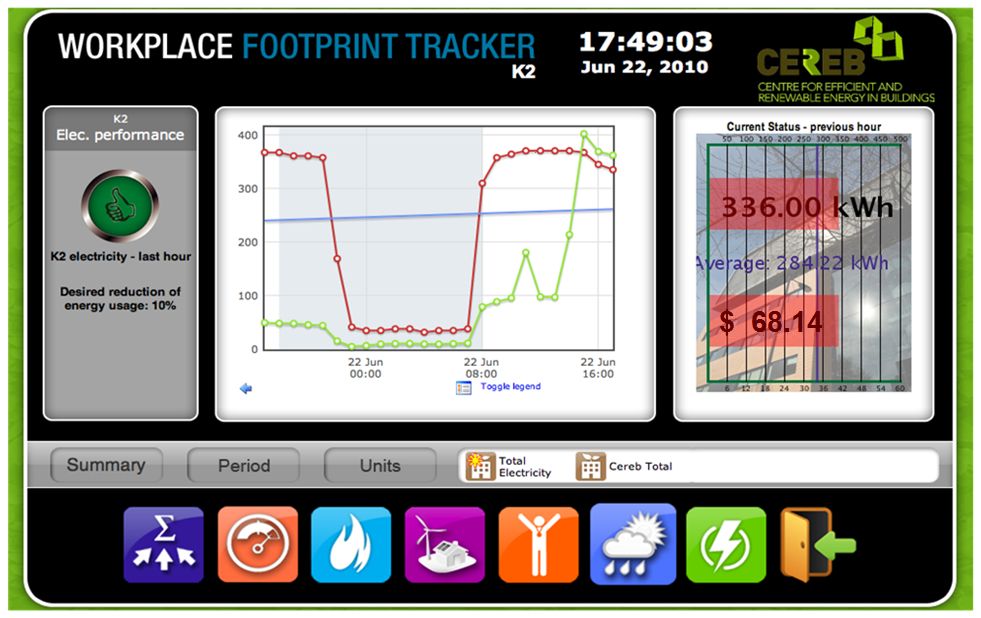from Intelligent Building Energy Management Systems

Peter M. Tarca
General Manager,
Intelligent Buildings Business Unit
PeopleCube
|
July 2011 |
[an error occurred while processing this directive] |
|
Economic and Workplace Efficiency
from Intelligent Building Energy Management Systems |
 Peter M. Tarca General Manager, Intelligent Buildings Business Unit PeopleCube |
| Articles |
| Interviews |
| Releases |
| New Products |
| Reviews |
| [an error occurred while processing this directive] |
| Editorial |
| Events |
| Sponsors |
| Site Search |
| Newsletters |
| [an error occurred while processing this directive] |
| Archives |
| Past Issues |
| Home |
| Editors |
| eDucation |
| [an error occurred while processing this directive] |
| Training |
| Links |
| Software |
| Subscribe |
| [an error occurred while processing this directive] |
Once just a “nice to have” in the corporate world, energy management
solutions are quickly transitioning into a necessity. Companies that
efficiently manage and reduce their energy consumption can achieve
significant cost reductions and reduced carbon emissions—and do it with
minimal risk.
Energy management solutions aren’t just beneficial to an organization’s
public image, they're also good for the bottom line. They can help
companies cut energy costs and benefit from tax incentives, and also
help them comply with government mandates.
The ROI of Energy Management
Brandt Smith, vice president and senior energy consultant for
Industrial Energy Audit Services, stated in an Industry Week article
that energy management is “the process of monitoring, controlling, and
conserving energy to maximize profits and minimize risk.”
[http://www.industryweek.com/articles/growing_your_bottom_line_through_energy_management_24265.aspx?ShowAll=1]
Employing an energy management system can pay off big for an
organization. In fact, companies have been able to cut their energy
costs by 30 percent or more simply by monitoring and controlling how
and when their energy is consumed.
Organizations often overlook the potential ROI from reducing their
energy consumption, but, according to Smith, “using a simple payback
(project cost/annual savings) these [sustainability] projects are
extremely attractive.” He states that 80 percent of the projects pay
for themselves in a year or less, 90 percent in less than 2 years, and
95 percent in less than 3 years.
The financial benefits are significant regardless of the economic
climate. During a strong economy, sustainability projects enhance a
company’s public image, while reducing the need for expansion, as they
tend to increase real-estate utilization and efficiency. In trying
times, energy management solutions help companies maximize
profitability by helping to lower energy and other operational costs.
Complying with Government Regulations
Beyond cost-cutting, energy-management initiatives help companies abide
by existing and forthcoming government laws and regulations regarding
energy usage and carbon reduction. Governments are increasingly passing
legislation that encourages organizations to gain better control over
their energy consumption.
Another way that energy management can pay off is in the form of
rebates and tax credits to businesses investing in relevant
initiatives. Incentives vary by location, but they can provide
significant savings. For example, the U.S.’s “Better Buildings
Initiative” offers commercial building owners a tax deduction for
energy-efficiency upgrades with the goal of making commercial buildings
20 percent more energy efficient over the next decade.
[http://www.whitehouse.gov/the-press-office/2011/02/03/president-obama-s-plan-win-future-making-american-businesses-more-energy]
The U.S. Federal Government is also implementing changes within its own
buildings to reduce energy consumption. On June 10, 2010, President
Obama signed a Memorandum to dispose of unneeded federal real estate in
hopes of increasing sales proceeds, cutting operating costs, and
improving energy efficiency.
The main goal of the Memorandum is “to eliminate wasteful spending of
taxpayer dollars, save energy and water, and further reduce greenhouse
gas pollution.” It states that “in total, agency efforts required by
this memorandum should produce no less than $3 billion in cost savings
by the end of fiscal year 2012…This is in addition to the Department of
Defense's Base Realignment and Closure efforts that are expected to
achieve $9.8 billion in savings from fiscal year 2010 to fiscal year
2012, of which $5 billion is a direct result of reduced operating and
maintenance from disposals or other consolidation efforts.”
States Get Into the Act
On a more local level, some state governments are requiring
organizations to control their own carbon emissions. For example,
California recently passed the Green Building Standards Code
(CALGREEN), which requires all new buildings within the state of
California to be more energy efficient and environmentally responsible
with the goal to attain significant reductions in energy consumption,
carbon emissions, and water use to create a greener California.
[http://www.bsc.ca.gov/CALGreen/greencode.htm]
The CALGREEN codes, which include reducing water consumption by 20
percent and mandatory inspections of energy systems for nonresidential
buildings over 10,000 square feet—to ensure that all are working at
their maximum capacity and according to their design efficiencies—will
be enforced in every new building constructed in the state.
On the other side of the country, Massachusetts plans to curb
heat-trapping gases emitted by homes, cars and businesses in the state
by being one of 10 states participating in the Regional Greenhouse Gas
Initiative, a cap-and-trade system for electric utilities.
[http://www.mass.gov/dep/air/climate/rggi.htm]
Measure and Visualize Energy Consumption
Energy management solutions offer the most efficient way for businesses
to conform to the new sustainability standards. Implementing a system
that shows when and where electricity and other energy sources are
being excessively consumed enables them to set up systems to control
when and how energy is being used. Not only does this help companies
comply with federal and local government mandates, it rewards them with
greater operational efficiency and significant cost-savings.
The first step in any energy management initiative is determining how
much energy is being consumed. According to Gartner analysts Stephen
Stokes and Simon Mingay, “Some of the lowest of the low-hanging,
energy-efficient fruit can be found in the energy footprint of
buildings. It has been estimated that they are the single-largest
consumer of electricity globally, and about 40 percent of this energy
consumption can be removed by implementing existing and mature
efficient technologies as well as operating and information
technologies.” [Simon Mingay, Bettina Tratz-Ryan, and Stephen Stokes,
“Hype Cycle for Sustainability and Greet IT, 2010” Gartner, Inc. July
29, 2010.]
Knowing when, where, and for how long energy is being consumed
throughout an organization is key to getting a handle on usage. Using
intuitive energy management dashboards, companies can capture, process,
and visualize their energy consumption to uncover ways to significantly
reduce energy costs.

Dashboards allow companies to identify what areas of the building are
consuming the most energy, analyze how much energy is being consumed
during a given time period, uncover trends in energy consumption, and
pinpoint inefficiencies to help better control how the organization is
managing its carbon output. They can also help companies benchmark
actual consumption against targeted goals.
Controlling Energy Use
Gaining visibility into energy consumption is essential, but the big
payoff comes when companies learn to manage energy more efficiently.
Once they understand where, when, and how energy is being used, they
can create policies and install systems to control usage and minimize
waste.
[an error occurred while processing this directive]The U.S. Environmental Protection Agency has said that up to 30 percent
of the energy consumed in commercial buildings is wasted. Real-estate
experts assert that 30-40 percent of commercial real estate typically
goes unused at any particular time. Gartner stated in its IWMS Magic
Quadrant Report, “With buildings responsible for almost 50 percent of
energy consumption and greenhouse gas emissions, establishing, managing
and maintaining sustainability objectives is fast becoming a core
driver for the deployment of IWMSs. Effective sustainability systems
must include the comprehensive collection of accurate energy
consumption and emissions data and the efficient analysis and
evaluation of that data to facilitate informed triage decisions that
optimize long-term sustainability.”
Advanced energy management solutions provide an automated way to manage
the amount of energy that is consumed in almost any area of a facility.
Integrating energy management solutions with building management
systems (BMS) enables organizations to dictate the energy consumption
of a meeting room, office, or other workspace based on the schedule for
that space.
For example, rather than maintaining a consistent temperature in a
conference room throughout the entire day, an energy management
solution that is integrated with a BMS can automatically control the
room climate based on when it is scheduled to be used. The room can be
kept at energy-efficient levels when not in use, then, just prior to
scheduled usage, the system can automatically trigger the BMS to adjust
the temperature to a comfortable level. Once the meeting has concluded,
the BMS can bring the temperature back to a more energy-efficient
level. This simple integration can provide an organization with
incredible cost-savings, without a big capital investment.
Win-Win from Energy Management
All over the world, companies are realizing significant benefits by
implementing energy management solutions. Gartner predicts that “by
2015, improving sustainability [will] become a top five priority for 60
percent of major Western European and North American CEOs.” [Simon
Mingay, Stephen Stokes, et al, “Predicts 2011: Sustainability Facing a
Long Path to Fruition,” Gartner, Inc. November 18, 2010]
By leveraging these solutions and integrating them into the workplace
framework, organizations can enhance their public image while complying
with government regulations, and significantly improve workplace
efficiency while cutting energy costs. That’s a win-win for the
environment and the bottom line.
ABOUT THE AUTHOR:
Peter Tarca is general manager, Intelligent Buildings
Business Unit, for PeopleCube, a provider of workplace-, resource-, and
energy-management technology that supports 8,000 customers and more
than 2.7 million users in small, medium, and large enterprises around
the world. A senior executive with broad experience in technology-based
businesses, including more 10 years at the CEO level, he specializes in
cleantech and energy efficiency, and has managed multi-disciplined
teams delivering complex products worldwide. Prior to joining
PeopleCube, he served in an executive capacity for several companies,
including CEO of Proliphix and managing director of Astroc Systems. His
affiliations include Clean Economy Network, CleanTech, Commercial
Building Automation, Energy Efficiency Professionals, Energy Technology
(ET) for Commercial Buildings, GreenBiz.com, Greener Buildings,
Greening of Commercial Facilities, Intelligent Buildings Research and
Innovation Network, OpenADR Alliance, Smart Buildings, and The Virtual
Energy Forum.
[an error occurred while processing this directive] [Home Page] [The
Automator] [About] [Subscribe
] [Contact
Us]
[Click Banner To Learn More]